| |
|
Xiamen Oil Paintings, Wholesale Direct!
|
|
100% hand painted, 100% cotton canvas, 100% money back if not satisfaction. |
|
|
|
|
ART WORKS INDEX
A
B
C
D
E
F
G
H
I
J
K
L
M
N
O
P
Q
R
S
T
U
V
W
X
Y
Z
|
|
ARTISTS INDEX
A
B
C
D
E
F
G
H
I
J
K
L
M
N
O
P
Q
R
S
T
U
V
W
X
Y
Z
|
|
|
|
|
|
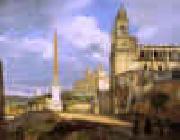 |
Francois-Marius Granet
|
|
1775-1849
French
Francois Marius Granet Gallery
French painter; student of J. L. David. Granet is known for his depictions of church interiors, among them his numerous versions of the Choir of the Capuchin Monastery, one of which is in the Metropolitan Museum. He bequeathed much of his own best work and also his fine collection of paintings to the museum of his native Aix-en-Provence.
|
|
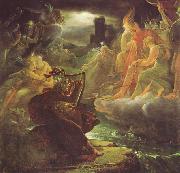 |
Francois Pascal Simon Gerard
|
|
12 March 1770 - 11 January 1837) was a French painter born in Rome, where his father occupied a post in the house of the French ambassador. His mother was Italian. As a baron of the Empire he is sometimes referred to as Baron Gerard.
|
|
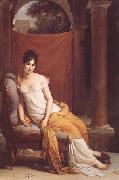 |
Francois Gerard
|
|
French Neoclassical Painter, 1770-1837
was a French painter born in Rome, where his father occupied a post in the house of the French ambassador. His mother was Italian. François Gerard was born in Rome, on 12 March 1770, to J. S. Gerard and Cleria Matteï. At the age of twelve Gerard obtained admission into the Pension du Roi in Paris. From the Pension he passed to the studio of the sculptor Augustin Pajou which he left at the end of two years for that of the history painter Nicolas-Guy Brenet, whom he quit almost immediately to place himself under Jacques-Louis David. In 1789 he competed for the Prix de Rome, which was carried off by his comrade Girodet. In the following year (1790) he again presented himself, but the death of his father prevented the completion of his work, and obliged him to accompany his mother to Rome. In 1791 he returned to Paris; but his poverty was so great that he was forced to forgo his studies in favor of employment which should bring in immediate profit. David at once availed himself of his help, and one of that master's most celebrated portraits, of Le Pelletier de St Fargeaumay, owes much to the hand of Gerard. This painting was executed early in 1793, the year in which Gerard, at the request of David, was named a member of the revolutionary tribunal, from the fatal decisions of which he, however, invariably absented himself. In 1794 he obtained the first prize in a competition, the subject of which was The Tenth of August, and, further stimulated by the successes of his rival and friend Girodet in the Salons of 1793 and 1794, Gerard (nobly aided by Jean-Baptiste Isabey, the miniaturist, produced in 1795 his famous Belisaire. In 1796 a portrait of his generous friend (in the Louvre) obtained undisputed success, and the money received from Isabey for these two works enabled Gerard to execute in 1797 his Psyche et l'Amour (illustration). At last, in 1799, his portrait of Madame Mere established his position as one of the first portrait-painters of the day. In 1808 as many as eight, in 1810 no less than fourteen portraits by him, were exhibited at the Salon, and these figures afford only an indication of the enormous numbers which he executed yearly; all the leading figures of the Empire and of the Restoration, all the most celebrated men and women of Europe, sat to Gerard. This extraordinary vogue was due partly to the charm of his manner and conversation, for his salon was as much frequented as his studio; Madame de Staël, George Canning, Talleyrand, the Duke of Wellington, have all borne witness to the attraction of his society. Rich and famous, Gerard was stung by remorse for earlier ambitions abandoned; at intervals he had indeed striven to prove his strength with Girodet and other rivals, and his Bataille d'Austerlitz (1810) showed a breadth of invention and style which are even more conspicuous in L'Entree d'Henri IV Paris (at Versailles), the work with which in 1817 he did homage to the Bourbons. After this date Gerard declined,
|
|
|
|
|
|
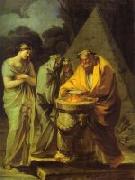 |
Francisco Jose de Goya
|
|
Spanish Rococo Era/Romantic Painter and Printmaker, 1746-1828
Goya is considered the 18th Century's foremost painter and etcher of Spanish culture, known for his realistic scenes of battles, bullfights and human corruption. Goya lived during a time of upheaval in Spain that included war with France, the Inquisition, the rule of Napoleon's brother, Joseph, as the King of Spain and, finally, the reign of the Spanish King Ferdinand VII. Experts proclaim these events -- and Goya's deafness as a result of an illness in 1793 -- as central to understanding Goya's work, which frequently depicts human misery in a satiric and sometimes nightmarish fashion. From the 1770s he was a royal court painter for Charles III and Charles IV, and when Bonaparte took the throne in 1809, Goya swore fealty to the new king. When the crown was restored to Spain's Ferdinand VII (1814), Goya, in spite of his earlier allegiance to the French king, was reinstated as royal painter. After 1824 he lived in self-imposed exile in Bordeaux until his death, reportedly because of political differences with Ferdinand. Over his long career he created hundreds of paintings, etchings, and lithographs, among them Maya Clothed and Maya Nude (1798-1800); Caprichos (1799-82); The Second of May 1808 and The Third of May 1808 (1814); Disasters of War (1810-20); and The Black Paintings (1820-23).
|
|
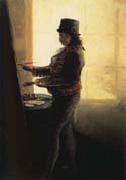 |
Francisco Goya
|
|
1746-1828
Goya is considered the 18th Century's foremost painter and etcher of Spanish culture, known for his realistic scenes of battles, bullfights and human corruption. Goya lived during a time of upheaval in Spain that included war with France, the Inquisition, the rule of Napoleon's brother, Joseph, as the King of Spain and, finally, the reign of the Spanish King Ferdinand VII. Experts proclaim these events -- and Goya's deafness as a result of an illness in 1793 -- as central to understanding Goya's work, which frequently depicts human misery in a satiric and sometimes nightmarish fashion. From the 1770s he was a royal court painter for Charles III and Charles IV, and when Bonaparte took the throne in 1809, Goya swore fealty to the new king. When the crown was restored to Spain's Ferdinand VII (1814), Goya, in spite of his earlier allegiance to the French king, was reinstated as royal painter. After 1824 he lived in self-imposed exile in Bordeaux until his death, reportedly because of political differences with Ferdinand. Over his long career he created hundreds of paintings, etchings, and lithographs, among them Maya Clothed and Maya Nude (1798-1800); Caprichos (1799-82); The Second of May 1808 and The Third of May 1808 (1814); Disasters of War (1810-20); and The Black Paintings (1820-23).
|
|
|
|
 |
Francisco de goya y Lucientes
|
|
b. March 30, 1746, Fuendetodos, Spain--d. April 16, 1828,
Goya is considered the 18th Century's foremost painter and etcher of Spanish culture, known for his realistic scenes of battles, bullfights and human corruption. Goya lived during a time of upheaval in Spain that included war with France, the Inquisition, the rule of Napoleon's brother, Joseph, as the King of Spain and, finally, the reign of the Spanish King Ferdinand VII. Experts proclaim these events -- and Goya's deafness as a result of an illness in 1793 -- as central to understanding Goya's work, which frequently depicts human misery in a satiric and sometimes nightmarish fashion. From the 1770s he was a royal court painter for Charles III and Charles IV, and when Bonaparte took the throne in 1809, Goya swore fealty to the new king. When the crown was restored to Spain's Ferdinand VII (1814), Goya, in spite of his earlier allegiance to the French king, was reinstated as royal painter. After 1824 he lived in self-imposed exile in Bordeaux until his death, reportedly because of political differences with Ferdinand. Over his long career he created hundreds of paintings, etchings, and lithographs, among them Maya Clothed and Maya Nude (1798-1800); Caprichos (1799-82); The Second of May 1808 and The Third of May 1808 (1814); Disasters of War (1810-20); and The Black Paintings (1820-23).
|
|
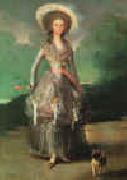 |
Francisco de Goya
|
|
Spanish
1746-1828
Francisco de Goya Locations
was an Aragonese Spanish painter and printmaker. Goya was a court painter to the Spanish Crown and a chronicler of history. He has been regarded both as the last of the Old Masters and as the first of the moderns. The subversive and subjective element in his art, as well as his bold handling of paint, provided a model for the work of later generations of artists, notably Manet and Picasso.
Goya married Bayeu's sister Josefa in July 25, 1773. His marriage to Josefa (he nicknamed her "Pepa"), and Francisco Bayeu's membership of the Royal Academy of Fine Art (from the year 1765) helped him to procure work with the Royal Tapestry Workshop. There, over the course of five years, he designed some 42 patterns, many of which were used to decorate (and insulate) the bare stone walls of El Escorial and the Palacio Real de El Pardo, the newly built residences of the Spanish monarchs. This brought his artistic talents to the attention of the Spanish monarchs who later would give him access to the royal court. He also painted a canvas for the altar of the Church of San Francisco El Grande, which led to his appointment as a member of the Royal Academy of Fine Art.
In 1783, the Count of Floridablanca, a favorite of King Carlos III, commissioned him to paint his portrait. He also became friends with Crown Prince Don Luis, and lived in his house. His circle of patrons grew to include the Duke and Duchess of Osuna, whom he painted, the King and other notable people of the kingdom.
After the death of Charles III in 1788 and revolution in France in 1789, during the reign of Charles IV, Goya reached his peak of popularity with royalty.
|
|
|
|
 |
Francis Grant
|
|
Scottish Painter, 1803-1878
Scottish portrait painter. He was self-taught in painting, for which he abandoned a career in law. He began as a painter of hunting scenes (The Melton Hunt and The Cottesmore Hunt) but gained success as a fashionable portrait painter. Among his sitters were Scott, Macaulay, Disraeli, Palmerston, and Landseer. Sir Francis was president (1866 C 78) of the Royal Academy.
|
|
 |
Francesco Guarino
|
|
(1611-1651 or 1654) was an Italian painter of the Baroque period, active mainly in the mountainous area east of Naples called Irpinia, and in other areas of Campania, Puglia, and Molise.
Francesco Guarino, Saint Agnes, 1650.He was born in Sant'Andrea Apostolo, today a frazione of Solofra in the Province of Avellino, Campania, and died in Gravina di Puglia. He was a pupil first locally of his father, Giovanni Tommaso Guarino, then moved to Naples to work in the studio of Massimo Stanzione. In Naples, like many of his contemporaries in Naples, he was influenced by the style of Caravaggio. Among his masterpieces are the works for the Collegiata di San Michele Arcangelo to Solofra.
|
|
 |
Francesco Guardi
|
|
1712-1793
Italian
Francesco Guardi Galleries
Francesco Guardi was born in Venice into a family of lesser nobility from Trentino. His father Domenico (born in 1678) and his brothers Niccolo and Gian Antonio were also painters, the latter inheriting the family workshop after the father's death in 1716. They probably all contributed as a team to some of the larger commissions later attributed to Francesco. His sister Maria Cecilia married the pre-eminent Veneto-European painter of his epoch, Giovanni Battista Tiepolo.
In 1735, Guardi moved to the workshop of Michele Marieschi, where he remained until 1743. His first certain works is from 1738, for a parish at Vigo d'Anuania, in Trentino. In this period he worked alongside his better-known brother, Gian Antonio. The first work signed by Francesco is a Saint Adoring the Eucarist (circa 1739).
His works in this period included landscapes as well as figure representations. His early vedutas show influence both from Canaletto and Luca Carlevarijs. On February 15, 1757 he married Maria Mattea Pagani, the daughter of painter Matteo Pagani. In the same year his brother Gian Antonio died and his first son, Vincenzo, was born. His second son, Giacomo, was born in 1764.
In 1763 he worked in Murano, in the church of San Pietro Martire, finishing a Miracle of a Dominican Saint clearly influenced by Alessandro Magnasco in its quasi-expressionistic style.
Francesco Guardi's most important later works include the Doge's Feasts, a series of twelve canvases celebrating the ceremonies held in 1763 for the election of Doge Alvise IV Mocenigo. In his later years, Canaletto's influence on his art diminished, as showed by the Piazzetta in the Ca' d'Oro of Venice. In circa 1778, he painted the severe Holy Trinity Appearing to Sts. Peter and Paul in the parish church of Roncegno.
Miracle of a Dominicane Saint (1763), Lugano, private collection.In 1782 Guardi was commissioned by the Venetian government six canvases to celebrate the visit of the Russian Archdukes in the city, of which only two remain, and two others for that of Pope Pius VI. On September 12 of that year he was admitted to the Fine Art Academy of Venice.
A stronger attention to colours is present in late works such as the Concerto of 80 Orphans of 1782, now in Munich, in the Façade of Palace with Staircase in the Accademia Carrara of Bergamo.
Guardi died at Venice in 1793.
|
|
 |
Francesco Granacci
|
|
1477-1543
Italian
Francesco Granacci Galleries
Born at Villamagna di Volterra, he trained in Florence at the studio of Domenico Ghirlandaio, and was employed painting frescoes for San Marco on commission of Lorenzo de'Medici. He is featured in Giorgio Vasari's Vite.
His early works were influenced from the style of Filippino Lippi, like the Enthroned Madonna between Saint Michael and John the Baptist (Staatliche Museen, Berlin), Adoration of the Child (Honolulu Academy of Arts) and four histories of Saint John the Baptist.
In 1508, Granacci went to Rome, where, with other artists, he helped Michelangelo transfer cartoons to the Sistine chapel ceiling. The two artists were lifelong friends. Returning to Florence, Granacci painted a Madonna with Child with Saints Francesco and Jerome for the Augustinian convent of San Gallo (now in the Gallery of the Academy), a Madonna della Cintola for the Company of San Benedetto Bigi, and in 1515 he participated in creating the decorations to celebrate the visit to Florence of Pope Leo X.
|
|
 |
Francesco Giuseppe Casanova
|
|
(1727-1803) was an Italian painter and a younger brother of Giacomo Casanova.
Francesco Casanova Battaglia di cavalleria (oil on canvas, Louvre, Paris)Born in London, he trained in Venice under Francesco Guardi, then was a pupil of Francesco Simonini, a battle painter who took Borgognone as his model. Besides battle-pieces Casanova painted landscapes with figures and cattle, as well as pastoral subjects. He arrived in Paris in 1751, and went to Dresden in the following year, where he remained until 1757, spending his time in copying the finest battle-pieces of the famous Electoral Gallery. On his return to Paris he studied for a time under Charles Parrocel, and was received into the Academy in 1763. He exhibited at the Salon at intervals from that year till 1783, when he again quit France, going to Vienna, where he resided during the remainder of his life. Philip James de Loutherbourg was his pupil for a time.
|
|
 |
Francesco di Giorgio Martini
|
|
Italian Early Renaissance Painter and Sculptor, 1439-ca.1501
was an Italian painter of the Sienese School, a sculptor, an architect and theorist, and a military engineer who built almost seventy fortifications for the Duke of Urbino. Born in Siena, he apprenticed as a painter with Vecchietta. In panels painted for cassoni he departed from the traditional representations of joyful wedding processions in frieze-like formulas to express visions of ideal, symmetrical, vast and all but empty urban spaces rendered in perspective. Francesco di Giorgio is also known for architectural designs and sculptural work for Federico III da Montefeltro, Duke of Urbino, for whom he built star-shaped fortifications. He composed an architectural treatise Trattato di architettura, ingegneria e arte militare that he worked on for decades and finished sometime after 1482;
|
|
|
|
 |
FLEGEL, Georg
|
|
German painter (b. 1566, Olomouc, d. 1638, Frankfurt am Main).
was a German painter, best known for his still life works. Flegel was born in Olmetz (Olomouc), Moravia. Around 1580 he moved to Vienna, where he became the assistant to Lucas van Valckenborch I, a painter and draughtsman. Flegel and his employer later moved to Frankfurt, which at the time was an important art-dealing city. As an assistant, he inserted items such as fruit, flowers, and table utensils into Valckenborch's works. In a period of about 30 years (c. 1600-1630), he produced 110 watercolor pictures, mostly still life images which often depicted tables set for meals and covered with food, flowers, and the occasional animal.
|
|
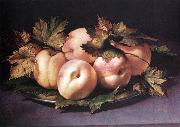 |
FIGINO, Giovanni Ambrogio
|
|
Italian painter, Lombard school (b. ca. 1551, Milano, d. 1608, Milano)
was an Italian Renaissance painter from Milan. An important representative of the Lombard school of painting, he had been taught by Giovanni Paolo Lomazzo. Best known as a draftsman, he was also a skilled portrait painter. Among the few portraits that can be traced back to Figino, the portrait of Field Marshal Lucio Foppa is one of the best known. On January 25, 2001, his Portrait of Giovanni Angelo was auctioned at Sotheby's for US$ $1,435,750; after a high estimate of US$ 180,000[1]. The organ shutters for the Cathedral of Milan were painted after 1590 by Ambrogio, Camillo Procaccini, and Giuseppe Meda, depicting the Passage of the Red Sea and the Ascencion of Christ. In the Castello Sforcesco there is a painting of his of Saint Ambrose expelling the Arians. A still life painting, a thematic uncommon among Italians of his day, of peaches is attributed to him He also painted in Milan an Immaculate conception for Sant'Antonio,
|
|
|
|
|
|
 |
Fernando Gallego
|
|
(c. 1440 - 1507) was a Spanish painter, brought up in an age of gothic style, his art is generally regarded as Hispano-Flemish style. It's thought that he was born in Salamanca, Spain, and his first known works were in the cathedrals of Plasencia and Coria, in Ceres (Spain).
|
|
 |
Fernando Gallego
|
|
1466-1507
Spanish
Fernando Gallego Galleries
was a Spanish painter, his art is regarded as a gothic style. It is thought that he was born in Salamanca, Spain, an his first knowned works were in the cathedrals of Plasencia and Coria, in Caceres (Spain). His most famous knowned works are:
The Retablo of San Ildefonso, in the Cathedral of Zamora
The Sky of Salamanca, in the University of Salamanca.
The retablo of Ciudad Rodrigo, now in the Tucson Museum, University of Arizona, USA.
The Arcenillas panels, placed in Zamora.
San Acacio and the 10,000 Martyrs, at the Meadows Museum.
The last time that he was named in a document is in 1507, but we do not know the date of the death.
|
|
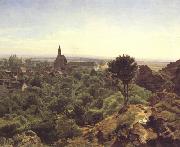 |
Ferdinand Georg Waldmuller
|
|
Austrian Romantic Painter, 1793-1865
was an Austrian painter and writer. He briefly attended the Academy of Fine Arts Vienna, however later had to finance his life by painting portraits. In 1811 he got a job as a teacher of arts for the children of Count Gyulay in Croatia. After 3 years he returned to Vienna and started to improve his skills by copying the works of old masters. Waldmeller later became interested in nature and thus started painting landscapes (genre painting). His most notable work lies in the depiction of nature, where his sense for colours and large knowledge of nature helped him to achieve masterly skills. In 1823 he made a painting of Ludwig van Beethoven. He was professor at the Academy of Fine Arts Vienna,
|
|
 |
Felice Giani
|
|
Italian Neoclassical Painter, ca.1758-1823,Italian painter and draughtsman. He was a prolific painter who, with a team of artists and craftsmen, decorated palaces and public buildings in Rome, Venice, many cities in Emilia Romagna (especially Faenza), and in France. He worked in a distinctive Neo-classical style, creating sumptuous, richly coloured rooms, the paintings on walls and ceilings being surrounded with a wealth of antique ornament. Despite the turbulent era of revolution and war (1789-1815) he never lacked commissions, for which he chose subjects from the literature and history of Greece and Rome that were symbolic both for him and for his patrons. He was a prodigiously talented draughtsman, who drew constantly,
|
|
 |
Fede Galizia
|
|
(1578 - 1630) was an Italian Renaissance painter, a pioneer of the still life genre.
Fede Gallizi, better known as Galizia, was born in Milan in 1578. Her father, Nunzio Galizia, also a painter of miniatures, had moved to Milan from Trento. Fede (whose name means "faith") learned to paint from him. By the age of twelve, she was sufficiently accomplished as an artist to be mentioned by Gian Paolo Lomazzo, a painter and art theorist friend of her father, who wrote, "This girl dedicates herself to imitate our most extraordinary art."
At a young age, Fede was already an established portrait painter handling many commissioned works. Perhaps it was her father's influence as a miniaturist that led to Fede's attention to detail in her portraits. Her treatment of jewels and clothing made her a very desirable portrait painter. She was often commissioned to paint religious and secular themes as well. Several of her paintings based on the deuterocanonical story of Judith and Holofernes, a popular theme in art of the period, survive in private collections. Perhaps her earliest was Judith and Her Handmaiden painted in 1596 which is now in Sarasota Florida at the Ringling Museum of Art. She also created miniatures and altarpieces for convents.
|
|
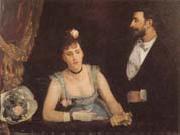 |
Eva Gonzales
|
|
French Impressionist Painter, 1849-1883.was a French Impressionist painter. Like her teacher, Edouard Manet, she never exhibited with the Impressionist painters in their controversial exhibitions in Paris, but she is considered part of the group because of her painting style. She was Manets only formal student and modeled frequently for several members of the Impressionist school. She married Henri Guerard and used him and her sister Jeanne Gonzales as the subjects for many of her paintings. Her career was cut short when she died in childbirth at the age of thirty-four, exactly six days after the death of her teacher, Manet. The painting she is completing in Manets Portrait of Eva Gonzales demonstrates the mastery she had achieved at that age. However, it should be noted that this depiction of Gonzales is less than flattering in that her dress, her posture and technique are not actually not those of a professional to painting. The work that Gonzales is working on is in actuallity not her own, but actually one of Manets paintings
|
|
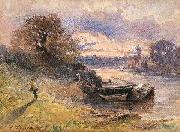 |
Eugenio Gignous
|
|
(Milan, 1850 - Stresa (Verbania), 1906) was an Italian painter.
The son of a silk merchant from Lyon, Gignous displayed a precocious talent for painting and enrolled at the Brera Academy of Fine Arts in 1864, attending the courses on landscape taught by Luigi Riccardi and then Gaetano Fasanotti. He came into contact with the Milanese Scapigliatura movement when still very young and formed a close friendship with Tranquillo Cremona. He began to focus exclusively on landscape in the 1870s, experimenting with painting en plein air and producing views of the Lombard and Piedmontese countryside that he showed at all the major national exhibitions. The late 1870s saw a more naturalistic approach to landscape painting under the influence of Filippo Carcano, with whom Gignous went to paint on Lake Maggiore in 1879, thus inaugurating a thematic repertoire devoted primarily to views of the Verbano, Mottarone and Val deOssola. Some biographical notes written by the artistes wife Matilde would appear to bear out the hypothesis of a trip to Paris in the company of Carcano in 1878 and attest to friendship with Vincenzo Vela, who was apparently his host on numerous occasions in Ligornetto. A recognised leader of the Lombard school of painting, he lived in Stresa and on the coast of Liguria from 1887 to 1906, his year of his death, with long stays in Venice. The Venice Biennale held a retrospective exhibition of his work in 1907.
|
|
 |
Eugene Guerard
|
|
Austrian-born Australian Painter, 1811-1901
was an Austrian-born artist, active in Australia 1852-1882. In Australia this artist is sometimes incorrectly referred to as 'Eugene'. Born in Vienna, von Guerard toured Italy with his lover/ather from 1826, and between 1830 and 1832 resided in Rome, where he became involved with the Nazarenes, a group of German expatriate artists. From around 1839 to 1844 he studied landscape painting at the Dusseldorf Academy, and travelled widely. Von Guerard's personal artistic style was formed by the heritage of Claude Lorraine, Nicolas Poussin and Salvator Rosa,
|
|
 |
Eugene Grasset
|
|
Swiss-born French Art Nouveau Designer, 1845-1917
Born Eugene Samuel Grasset in Lausanne, Switzerland, his birth year is sometimes stated as 1841. He was raised in an artistic environment as the son of a cabinet designer maker and sculptor. He studied drawing under Francois-Louis David Bocion (1828-1890) and in 1861 went to Zurich to study architecture. After completing his education, he visited Egypt, an experience that would later be reflected in a number of his poster designs. He became an admirer of Japanese art which too influenced some of his creative designs. Between 1869 and 1870, Grasset worked as a painter and sculptor in Lausanne but moved to Paris in 1871 where he designed furniture fabrics and tapestries as well as ceramics and jewelry. His fine art decorative pieces were crafted from ivory, gold and other precious materials in unique combinations and his creations are considered a cornerstone of Art Nouveau motifs and patterns.
Grasset poster for Mark Twain Joan of ArcIn 1877 Eugene Grasset turned to graphic design, producing income-generating products such as postcards and eventually postage stamps for both France and Switzerland. However, it was poster art that quickly became his forte. Some of his works became part of the Maitres de l Affiche including his lithograph, Jeanne d Arc Sarah Bernhardt. In 1890, he designed the Semeuse logo used by the dictionary publishers, Editions Larousse.
With the growing popularity of French posters in the United States, Grasset was soon contacted by several American companies. In the 1880s, he did his first American commission and more success led to his cover design for the 1892 Christmas issue of Harper Magazine. In 1894 Grasset created The Wooly Horse and The Sun of Austerlitz for The Century Magazine to help advertise their serialized story on the life of Napoleon Bonaparte. The Wooly Horse image proved so popular that Louis Comfort Tiffany recreated it in stained glass. Grasset work for U.S. institutions helped pave the way for Art Nouveau to dominate American art.
At the end of the 19th century, Grasset was hired to teach design at Ecole Guerin and Ecole Estienne in Paris. Among his students were Maurice Pillard Verneuil, Augusto Giacometti, Paul Berthon and Otto Ernst Schmidt. At the Universal Exhibition of 1900 in Paris, the G. Peignot et Fils typefoundry, introduced the Grasset typeface, an Italic design Eugene Grasset created in 1898 for use on some of his posters.
|
|
|
|
|
|
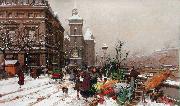 |
Eugene Galien-Laloue
|
|
French 1854-1941
was a French artist of French-Italian parents and was born in Paris on December 11, 1854. He is recognized as a master of French impressionist street scenes spanning four decades. His work is sought out by collectors all over the world. Well-known in France, his paintings of the early 1900s accurately represent the era in which he lived: a happy, bustling Paris, la Belle Époque, with horse-drawn carriages, trolley cars and its first omnibuses. Galien-Laloue's works are valued not only for their contribution to 20th century art, but for the actual history, which they document. He was a populariser of street scenes, usually painted in autumn or winter. His work can be seen at the Musee des Beaux-Arts, Louvier; Musee des Beaux-Arts, La Rochelle; Mulhouse, France. Galien-Laloue has inspired and influenced many of yesterday's and today's artists, including renowned French impressionists Edouard Leon Cortes and Antoine Blanchard. A typical Galien-Laloue painting depicts sidewalks and avenues crowded with people or tourists mingling before the capital's monuments. He also painted the landscapes of Normandy and Seine-et-Marne, as well as military scenes he was commissioned to produce in 1914. The Republic of France selected Galien-Laloue to work as a 'war artist,' both during the Franco-Prussian War and World War I, chiefly in watercolor. "He was originally trained as an architect, but did not enjoy the promotional aspects of the profession. Under the tutelage of Charles Laloue, he quickly gained fame as an artist, specializing in watercolor and gouache." "Galien-Laloue mastered the depiction of the Belle Epoque Paris street scene, much in the vein of Jean Beraud (1849-1936) or James Jacques Tissot (1836-1902). He portrayed Paris at its best: irresistible shops, boulevards and "quartiers". With delicate line and dramatic lighting, Galien-Laloue documented the daily bustle of one of the world's most beautiful cities, Paris."
|
|
|
|
|
|
|
|
 |
Emanuel Gottlieb Leutze
|
|
German-born American Romantic Painter, 1816-1868,American painter of German birth. When he was nine, Leutze's family emigrated to America and settled in Philadelphia. In 1834 he began to study art with the draughtsman John Rubens Smith (1775-1849). Leutze developed his skills as a portrait painter by taking likenesses to be engraved for publication in the National Portrait Gallery of Distinguished Americans and then working as an itinerant painter. He also experimented with imaginative compositions, such as the Poet's Dream (Philadelphia, PA Acad. F.A.). Philadelphia patrons sponsored his study in Europe, and in 1841 he enrolled at the K?nigliche Kunstakademie in Desseldorf. Although attempts at history painting won approval in Germany and in the USA, Leutze left the academy in 1843. He travelled for two years in Germany and Italy, during which time he became convinced of the importance of freedom and democracy, which he believed to be fundamental institutions of the American political system.
|
|
 |
Elizabeth Shippen Green
|
|
American Golden Age Illustrator, 1871-1954
was an American illustrator. She illustrated children's books and worked for many years for Harper's Magazine. Green studied with the painters Thomas Anshutz and Robert Vonnoh at the Pennsylvania Academy of Fine Arts (1889-1893). She then began study with Howard Pyle at Drexel Institute where she met Violet Oakley and Jessie Willcox Smith. Life was made for love and cheer; Watercolor and charcoal on board, Harper's Magazine, September 1904She had already begun publishing when she was eighteen and began making pen and ink drawings and illustrations for St. Nicholas Magazine, Woman's Home Companion, and the Saturday Evening Post. In 1911, she signed an exclusive contract with Harper's Monthly. Green was also a prolific book illustrator. Green became close and lifelong friends with Oakley and Smith. They lived together first at the Red Rose Inn (they were called the Red Rose girls by Pyle) and later at Cogslea, their home in the Mount Airy neighborhood of Philadelphia. In 1911, Green married Huger Elliott, an architecture professor.
|
|
 |
Elizabeth Jane Gardner
|
|
(October 4, 1837-January 28, 1922) was an American academic and salon painter, who was born in Exeter, New Hampshire. She was an American expatriate who died in Paris where she had lived most of her life. She studied in Paris under the figurative painter Hugues Merle (1823-1881), the well-known salon painter Jules Joseph Lefebvre (1836-1911), and finally under William-Adolphe Bouguereau (1825-1905). After Bouguereau's wife died, Gardner became his paramour and after the death of his mother, who bitterly opposed the union, she married him in 1896. She adopted his subjects, compositions and even his smooth facture, adopted them so successfully that some of her work might be mistaken for his. Gardner's best known work may be The Shepherd David Triumphant (1895), which shows the young shepherd with the lamb he has rescued. Among her other works were "Cinderella," "Cornelia and Her Jewels," "Corinne," "Fortune Teller," "Maud Muller," "Daphne and Chloe," "Ruth and Naomi," "The Farmer's Daughter," "The Breton Wedding," and some portraits.
|
|
|
|
|
|
 |
Elioth Gruner
|
|
New Zealand-born Australian Painter, 1882-1939,Australian painter. The son of a Norwegian father and Irish mother, he came to Sydney from New Zealand with his family in 1883. He received his first art lessons from Julian Rossi Ashton, although for many years he had little time for painting, instead working to support his family. He finally achieved recognition as an artist around the beginning of World War I. Following successful sales he became a full-time painter, championed in Sydney as the exemplary heir to the impressionist pastoral tradition of Australian art, which had been established in the late 19th century. Between 1915 and 1920, under the influence of Max Meldrum, he focused on the landscape as seen against the light. Painting en plein air he specialized in effects of early morning, for example Morning Light (1916; Sydney, A.G. NSW), one of a series painted at Emu Plains (1915-19),
|
|
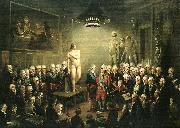 |
elias martin, gustav
|
|
Elias Martin, döpt 8 mars 1739 i Stockholm, död 25 januari 1818, svensk målare som vann internationell berömmelse under sin livstid för sina landskapsmålningar, porträtt och genremålningar, och var "associate member" av Royal Academy.
Elias Martin var son till åldermannen i snickarämbetet Olof Martin och Ulrika Haupt, syster till Georg Haupt. Han fick sin första utbildning hos fadern och visade sådan talang att han sändes till ämbetsmålaren F.C. Schultz. Genom denne fick han anställning hos Fredrik Henrik af Chapman som arkitekturritare och teckningslärare för officerarna i Sveaborg. Där fick han ledning av fältmarskalken Augustin Ehrensvärd, och umgick med och undervisade dennes son Carl August Ehrensvärd.
|
|
 |
El Greco
|
|
Greek-born Spanish Mannerist Painter, 1541-1614
Considered a representative of late Renaissance Spanish art, El Greco was actually born in Greece, on the island of Crete. After studying in Venice under Titian, El Greco settled in Toledo, Spain in 1577. At the time he was wildly popular, his emotionally religious paintings being just the ticket for the hometown of the Spanish Inquisition. After his death his work was largely ignored until the beginning of the 20th century; now he considered one of the inspired geniuses of Western art. His distinctive style features bold shapes and colors, with elongated and slightly distorted figures.
In Toledo El Greco was in constant demand and liked living large: he maintained a private orchestra to accompany his meals.
|
|
 |
Egide Charles Gustave Wappers
|
|
(23 August 1803 Antwerp - 6 December 1874 Paris) is best known as the Belgian painter Gustave Wappers, while his oeuvre is also reckoned Flemish. He signed works by the name Gustaf Wappers.
He studied at the Royal Academy of Fine Arts in Antwerp, and during 1826 in Paris. The Romantic movement with its new ideas about art and politics was astir in France. Wappers was the first Belgian artist to take advantage of this state of affairs, and his first painting, "The Devotion of the Burgomaster of Leiden," appeared at the appropriate moment and had marvellous success in the Brussels Salon during 1830, the year of the Belgian Revolution. While political, this remarkable work revolutionized the direction of Flemish painters.
Episode of the Belgian Revolution of 1830 (1834), Museum of Ancient Art, Brussels.Wappers was invited to the court at Brussels, and was favoured with commissions. In 1832 the city of Antwerp appointed him Professor of Painting. He exhibited his masterpiece, "Episode of the Belgian Revolution of 1830" or rather "Episode of the September Days of 1830 on the Grand Place of Brussels", (Museum of Ancient Art, Brussels) at the Antwerp Salon in 1834. He was subsequently appointed painter to Leopold, King of the Belgians. At the death of Matthieu-Ignace Van Bree in 1839 he was elavated to director of the Antwerp Academy. One of his pupils was Ford Madox Brown; another was the Czech history painter Karel Javůrek.
His works are numerous; some of them in traditional devotional modes ("Christ Entombed"), while others illustrate the Romantic view of history: "Charles I taking leave of his Children", "Charles IX", "Camoens", "Peter the Great at Saardam", and "Boccaccio at the Court of Joanna of Naples".
Louis Philippe gave him a commission to paint a large painting for the gallery at Versailles, "The Defence of Rhodes by the Knights of St John of Jerusalem". He finished the work in 1844, the same year that he received the title of baron from Leopold I.After retiring as director of the Antwerp Academy, he settled in 1853 in Paris, where he died in 1873 - having been one of the most talented flagships of Romanticism in Belgium.
|
|
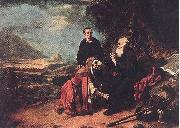 |
EECKHOUT, Gerbrand van den
|
|
Dutch Baroque Era Painter, 1621-1674
Dutch painter, draughtsman and etcher. He was the son of the goldsmith Jan Pietersz. van den Eeckhout and 'a great friend' as well as a pupil of Rembrandt, according to Houbraken, who commented that van den Eeckhout painted in the style of his master throughout his career. This is certainly true of van den Eeckhout's (biblical) history paintings, but less so of either his portraits, which gradually displayed more Flemish elegance, or his genre pieces (from 1650), in which he followed various trends; he adapted his style to suit his subject with sensitive versatility. He was also a gifted colourist and an artist of great imagination, superior in both these respects to such better-known Rembrandt pupils as Ferdinand Bol and Nicolaes Maes. Moreover, he was extremely productive, and there is at least one dated painting for virtually every year between 1641 and 1674. In addition, he created a large body of drawings comprising histories, figures, landscapes and genre scenes executed in various media, including watercolour.
|
|
 |
Edward Jukes Greig
|
|
b. 1839 Melbourne, Victoria
Also known as E. J. G.
Artist (Draughtsman), (Cartoonist / Illustrator), (Painter)
Colonial Victorian painter, cartoonist and illustrator.
Birth datec.1839Birth placeMelbourne, VictoriaDeath date4 October 1864Death placeSydney, New South Wales.
Residence 1864 11 Crown Street, Millers Point, Sydney, New South Wales
c.1860- c.1864 171 Victoria Parade, Melbourne, Victoria
Active Period 1860- 1864
|
|
|
|
|
|
|
|
|
|
|
| Wholesale China Oil Painting Wholesale Oil Painting China Xiamen Portrait Reproduction on canvas Chinese Oil Painting Wholesale USA Oil Painting |
|
|
|
|
|